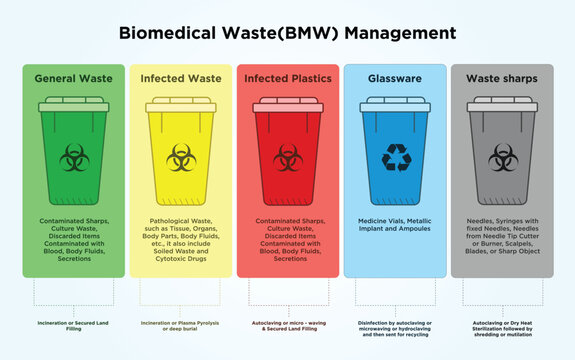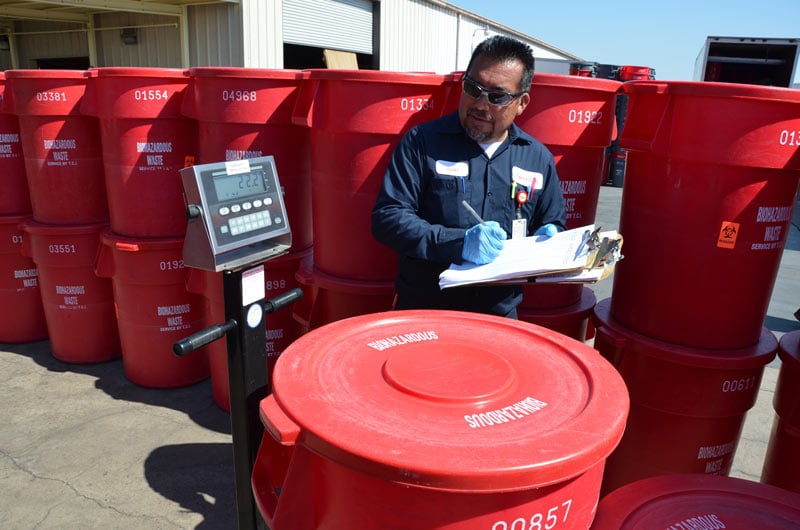Effective and Responsible Medical Waste Removal: Protecting People and the World
Wiki Article
Ideal Practices for Medical Waste Monitoring
Medical waste management is a crucial element of healthcare facilities' operations to guarantee the safety of clients, personnel, and the atmosphere. Applying ideal techniques in clinical waste administration is necessary to lessen the dangers related to contaminated materials. This consists of proper segregation and categorization of waste, ensuring its safe storage space and labeling, adhering to governing standards, and utilizing effective disposal methods. By complying with these best methods, medical care facilities can reduce the potential for infections, injuries, and pollution brought on by inappropriate handling and disposal of clinical waste. This intro intends to provide an overview of the importance of finest methods for medical waste management and the succeeding areas will certainly look into each practice thoroughly - medical waste disposal service.
Partition and Categorization
In the area of clinical waste monitoring, correct segregation and categorization are crucial techniques for ensuring the efficient and safe disposal of healthcare-related products. Medical waste is created from different sources, consisting of medical facilities, facilities, laboratories, and various other medical care facilities. It is composed of a large range of items, such as needles, syringes, plasters, gloves, and pharmaceutical waste.Segregation includes the systematic splitting up of various kinds of medical waste based on their qualities and possible risks. Sharps waste, such as blades and needles, should be positioned in puncture-resistant containers to protect against injuries and the spread of contagious diseases.
Classification is the process of identifying medical waste right into different classifications based upon its possible dangers. These classifications may consist of transmittable waste, hazardous waste, pharmaceutical waste, and general waste. By classifying waste, medical care facilities can determine the ideal disposal methods and guarantee compliance with regional policies and standards.
Correct segregation and categorization of medical waste not just shield the health and wellness of healthcare workers and the public yet also add to the overall effectiveness and effectiveness of waste monitoring. It reduces the danger of mishaps, minimizes environmental influences, and advertises liable waste disposal techniques.
Appropriate Storage Space and Labeling
To ensure the reliable and safe disposal of clinical waste, health care centers should comply with proper storage space and labeling practices. WasteX Medical Waste Disposal. Proper storage and labeling play an essential duty in keeping the honesty of medical waste management systems and securing the health and wellness of healthcare workers, patients, and the basic publicWhen it comes to storage, it is necessary to have actually marked locations specifically designed for different types of clinical waste. These areas need to be secure, well-ventilated, and outfitted with suitable containers that satisfy regulatory criteria (medical waste disposal). Segregation and categorization of waste must also be considered to stay clear of cross-contamination and potential hazards

Normal tracking and examination of storage space locations and containers are vital to identify any issues or offenses. Personnel needs to be educated on correct storage space and labeling practices, stressing the relevance of compliance with procedures and laws.
Safe Transport and Handling
Guaranteeing the safe and secure and correct transportation and handling of medical waste is critical for maintaining the integrity of waste monitoring systems and guarding the health and security of all entailed. Clinical waste, that includes things infected with infectious materials, pharmaceuticals, and other hazardous compounds, must be transferred in a way that protects against leaks, spills, and prospective contamination.To achieve secure transportation and handling, several best methods ought to be adhered browse around here to. First, it is important to use watertight and puncture-resistant containers that are particularly made for medical waste. These containers ought to be correctly secured and labeled to stop any kind of unintended direct exposure or mishandling. Additionally, waste must be set apart based on its nature and kind to avoid cross-contamination.
During transport, it is necessary to guarantee that waste containers are firmly secured and kept in a steady way. Automobiles utilized for transferring medical waste ought to be geared up with suitable safety functions, such as spill control systems, to minimize the threat of any kind of leakages or spills. Chauffeurs ought to obtain training on correct handling and emergency situation action procedures to effectively resolve any unanticipated incidents.
In addition, the transport and handling of medical waste need to conform with all relevant policies and guidelines stated by neighborhood, state, and federal authorities. WasteX Medical Waste Disposal. medical waste disposal service. Routine assessments and audits should be conducted to analyze compliance and recognize any kind of locations for renovation
Conformity With Regulatory Guidelines
Maintaining compliance with governing guidelines is vital for reliable medical waste monitoring. These standards are put in location to shield public health and wellness and the setting by making certain that clinical waste is correctly taken care of, treated, and disposed of. Conformity with regulatory standards aids to stop the spread of infectious illness, lessen potential dangers, and lower the general influence of medical waste on the atmosphere.To accomplish compliance, medical care facilities need to remain informed regarding the specific policies regulating clinical waste monitoring in their territory. These guidelines might vary from country to nation, and even within various states or areas. It is very important for medical care facilities to have an extensive understanding of these standards and to implement ideal approaches and methods to guarantee conformity.
One key aspect of compliance is the appropriate segregation and labeling of different types of medical waste. This consists of separating sharps from other waste, in addition to classifying waste based on its prospective threats. Healthcare centers have to additionally guarantee that clinical waste is stored in ideal containers which these containers are appropriately labeled and sealed.
In addition, conformity with regulatory standards calls for health care facilities to develop proper training and education programs for personnel associated with clinical waste monitoring. This includes supplying training on waste partition, handling, and disposal treatments, along with the proper use personal safety tools.
Normal monitoring and audits are likewise necessary to ensure recurring compliance with regulatory guidelines. This involves carrying out routine evaluations of waste storage locations, documenting waste monitoring procedures, and keeping records of garbage disposal.
Effective Disposal Approaches
Medical care facilities need to employ efficient disposal approaches for appropriate monitoring of clinical waste. Improper disposal of medical waste can posture significant wellness and ecological risks. There are several techniques that can be made use of to efficiently dispose of medical waste, ensuring the safety and security of healthcare workers, patients, and the basic public.One generally used method is incineration. Burners can safely melt clinical waste at high temperatures, lowering the quantity and damaging any possibly damaging pathogens. Nonetheless, incineration can be costly and may launch harmful pollutants into the air if not appropriately regulated.
Another approach is autoclaving, which includes subjecting the waste to high-pressure heavy steam. This procedure kills microorganisms, viruses, and various other microorganisms, making the waste risk-free for disposal in routine waste streams. Autoclaving is a effective and eco friendly approach, however it needs specific equipment and qualified workers.
Chemical disinfection is additionally made use of in many cases, where liquid chemicals are related to the waste to disinfect it. This approach is much less frequently made use of because of issues about the effectiveness of chemical disinfection and the possibility for chemical deposits to pollute the environment.
In addition to these techniques, healthcare facilities should also carry out proper segregation, product packaging, and labeling of medical waste to guarantee its risk-free handling and disposal. Regular training and education of team on correct waste management methods are vital to keeping effective disposal methods.
Final Thought
Finally, applying ideal practices for medical waste management is essential for making certain the safety and security of health care workers, patients, and the setting. By correctly setting apart and classifying waste, saving and labeling it appropriately, making certain safe transportation and handling, conforming with regulatory standards, and employing efficient disposal approaches, health care centers can successfully handle and lessen the dangers associated with medical waste. It is essential for medical care organizations to stick and focus on to these finest practices to keep a lasting and safe medical care atmosphere.Medical waste management is a vital element of healthcare facilities' operations to make certain the safety and security of patients, staff, and the setting. Implementing ideal practices in clinical waste management is vital to decrease the risks associated with harmful waste. These groups might consist of transmittable waste, hazardous waste, pharmaceutical waste, and general waste.In conclusion, applying best methods for medical waste management is vital for making sure the safety and security of health care workers, clients, and the setting. By appropriately setting apart and classifying waste, keeping and identifying it correctly, ensuring safe transport and handling, conforming with regulatory guidelines, and employing reliable disposal techniques, health care centers can efficiently manage and reduce the dangers linked with medical waste.
Report this wiki page